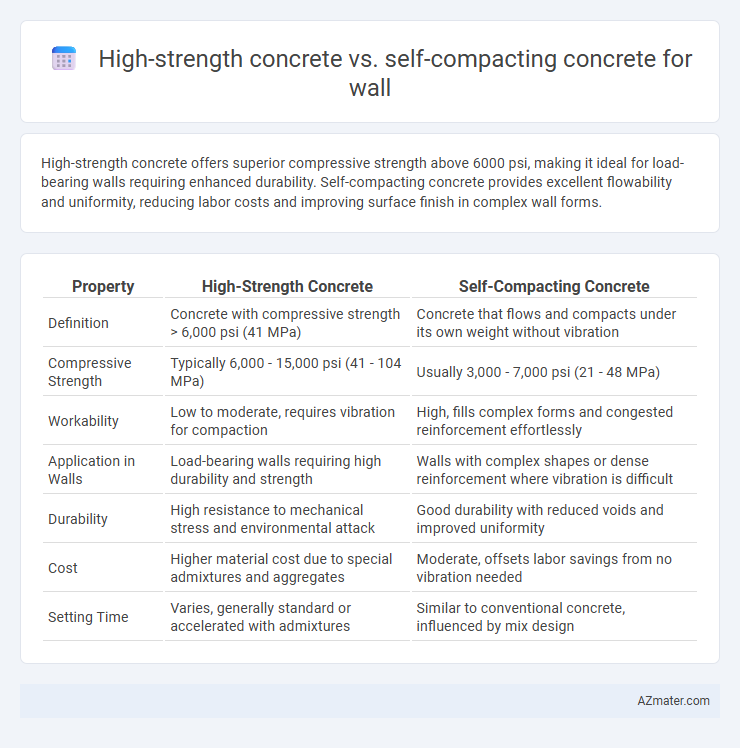High-strength concrete offers superior compressive strength above 6000 psi, making it ideal for load-bearing walls requiring enhanced durability. Self-compacting concrete provides excellent flowability and uniformity, reducing labor costs and improving surface finish in complex wall forms.
Table of Comparison
| Property | High-Strength Concrete | Self-Compacting Concrete |
|---|---|---|
| Definition | Concrete with compressive strength > 6,000 psi (41 MPa) | Concrete that flows and compacts under its own weight without vibration |
| Compressive Strength | Typically 6,000 - 15,000 psi (41 - 104 MPa) | Usually 3,000 - 7,000 psi (21 - 48 MPa) |
| Workability | Low to moderate, requires vibration for compaction | High, fills complex forms and congested reinforcement effortlessly |
| Application in Walls | Load-bearing walls requiring high durability and strength | Walls with complex shapes or dense reinforcement where vibration is difficult |
| Durability | High resistance to mechanical stress and environmental attack | Good durability with reduced voids and improved uniformity |
| Cost | Higher material cost due to special admixtures and aggregates | Moderate, offsets labor savings from no vibration needed |
| Setting Time | Varies, generally standard or accelerated with admixtures | Similar to conventional concrete, influenced by mix design |
Introduction: Comparing High-Strength and Self-Compacting Concrete for Walls
High-strength concrete offers superior compressive strength ideal for load-bearing walls requiring enhanced durability and reduced thickness. Self-compacting concrete flows effortlessly into complex wall molds, ensuring excellent surface finish and minimal vibration during placement. Both materials optimize wall construction but cater to different structural and architectural needs.
Material Composition: High-Strength Concrete vs Self-Compacting Concrete
High-strength concrete incorporates a low water-cement ratio, high cement content, and supplementary cementitious materials like silica fume to achieve compressive strengths exceeding 60 MPa, offering enhanced durability and load-bearing capacity for walls. Self-compacting concrete features fine aggregates, superplasticizers, and a carefully optimized mix design to ensure high flowability and segregation resistance without mechanical vibration, maintaining strengths typically ranging from 30 to 50 MPa. The key difference lies in high-strength concrete prioritizing mechanical performance through dense microstructure, while self-compacting concrete emphasizes workability and ease of placement, impacting their suitability for wall applications based on structural and construction requirements.
Workability and Placement Differences
High-strength concrete offers superior compressive strength but requires careful vibration and placement, often leading to challenges in achieving uniform compaction in wall applications. Self-compacting concrete excels in workability, flowing effortlessly into complex formwork and densely reinforcing areas without mechanical vibration, ensuring homogeneous placement. The key difference lies in self-compacting concrete's ability to maintain flowability and stability, minimizing labor and improving surface finish in vertical structures compared to the more rigid, vibration-reliant high-strength concrete.
Structural Performance in Wall Applications
High-strength concrete offers superior compressive strength and load-bearing capacity, making it ideal for structural walls requiring durability and resistance to heavy loads. Self-compacting concrete enhances structural performance by ensuring uniform filling and eliminating voids, which reduces weak points and improves overall wall integrity. Combining high strength with excellent flowability, self-compacting high-strength concrete optimizes wall construction by delivering enhanced mechanical properties and improved durability.
Durability and Longevity Considerations
High-strength concrete exhibits superior compressive strength and reduced permeability, enhancing durability and resistance to environmental stressors for wall applications. Self-compacting concrete improves uniformity and reduces voids, which also contributes to long-term durability by minimizing crack formation and ingress of harmful agents. Both concretes offer distinct longevity benefits, with high-strength concrete favoring load-bearing capacity and self-compacting concrete promoting enhanced structural integrity through improved compaction and homogeneity.
Construction Speed and Labor Requirements
High-strength concrete offers superior load-bearing capacity but requires extensive vibration and skilled labor, slowing construction speed and increasing labor costs for wall applications. Self-compacting concrete flows easily into formwork without vibration, significantly reducing construction time and labor requirements while maintaining adequate strength for typical walls. Using self-compacting concrete can streamline wall construction by minimizing manual intervention and improving uniformity.
Surface Finish and Aesthetic Results
High-strength concrete offers superior durability and structural integrity but may require additional finishing efforts to achieve a smooth surface, often resulting in a more utilitarian appearance for walls. Self-compacting concrete provides excellent flowability and compaction without vibration, leading to highly uniform surfaces with minimal blemishes, ideal for aesthetic wall finishes with intricate details. The choice between these concretes depends on the desired balance between load-bearing capacity and the visual quality of the wall surface.
Cost Analysis: High-Strength vs Self-Compacting Concrete
High-strength concrete typically demands higher cement content and specialized admixtures, leading to increased material and production costs compared to self-compacting concrete, which emphasizes flowability with reduced labor expenses due to its easy placement. Self-compacting concrete reduces the need for vibration labor, cutting installation time and associated costs, while high-strength concrete incurs higher testing and quality control expenditures. Overall, self-compacting concrete offers cost efficiency in construction phases, whereas high-strength concrete results in greater upfront material investments for enhancements in structural performance.
Environmental Impact and Sustainability
High-strength concrete typically requires higher cement content, leading to increased CO2 emissions and a larger carbon footprint compared to self-compacting concrete (SCC), which often incorporates supplementary cementitious materials reducing environmental impact. SCC improves sustainability by minimizing construction waste and labor while enhancing durability and reducing the need for repairs, contributing to a longer service life. Choosing SCC for wall applications supports eco-friendly construction practices through optimized material use and decreased energy consumption during placement and curing.
Choosing the Right Concrete for Your Wall Project
High-strength concrete offers superior compressive strength, making it ideal for load-bearing walls requiring durability and structural integrity. Self-compacting concrete enhances workability and surface finish, reducing labor and ensuring precise placement in complex forms or densely reinforced areas. Selecting the right concrete depends on project requirements, balancing strength needs with ease of application and finishing quality for optimal wall performance.

Infographic: High-strength concrete vs Self-compacting concrete for Wall
 azmater.com
azmater.com